Dirk Reinartz
deathly still
All photographs from deathly still are prints being made by Dirk Reinartz
each Silbergelatine-Print, 25,5 x 16,5 cm, resp. 16,5 x 25,5 cm
each Silbergelatine-Print, 25,5 x 16,5 cm, resp. 16,5 x 25,5 cm
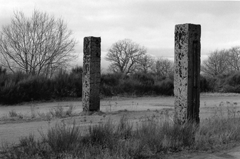
Natzweiler, Steinbruch, Torpfeiler, 1993
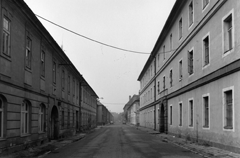
Theresienstadt, Bahnhofsstraße, 1987
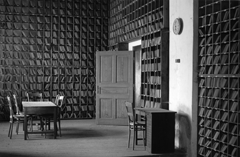
Theresienstadt/Kleine Festung, Häftlingskartei, 1987
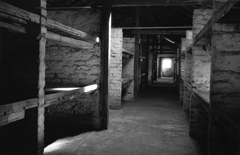
Auschwitz II/Birkenau, Ziegelbaracke, 1993
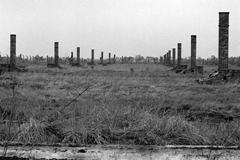
Auschwitz II/Birkenau, Gesamtansicht, 1993
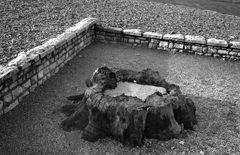
Buchenwald, Stumpf der Goethe Eiche, 1992
Exhibition view, deathly still, Galerie m Bochum, 1994/1995
At the sites of the German concentration camps
by Dirk Reinartz
This book project actually began to take shape long before I started working as a photographer – probably as early as my school days in the 1950s and 60s. I had already begun back then to ask questions about the past, especially about the days of National Socialism, which often prompted only vague answers or attempts at justification.
After having traveled abroad extensively for STERN magazine in the 1970s (North and South America, Africa, Japan, Indonesia, the Soviet Union, Eastern Europe, etc.), I decided to work as a freelancer and to concentrate on German themes, in addition to works on art and artists.
This led, among other things, to a few city portraits and to the project "Neue Heimat - eine deutsche Kleinstadt, z. B. Buxtehude" (exhibition and catalogue), as well as to the books "Kein schöner Land. Deutschlandbilder," "Besonderes Kennzeichen: deutsch," "Deutschlandreportagen," and "Bismarck. Vom Verrat der Denkmäler," all published by Steidl Verlag. My occupation with German themes meant I had to come to terms with the Nazi era and its manifestations and legacy. I did photographs for reports and essays, including images of the Nuremberg Rally grounds, the Oder-Neisse line, the Theresienstadt concentration camp, and the story of an SS man who lived for a long time unrecognized in a small village in Hessen.
After Willy Brandt's visit to the Stutthof concentration camp during a trip to Poland, and then a reportage I did on juvenile offenders who were doing time at the Vierlande detention center – which is located on the grounds of the former Neuengamme concentration camp – and then another report on Theresienstadt, I began to travel to German concentration camp sites, primarily to document what was still there and to search for answers to these questions:
• Do the remains of the camps give us any insights into the system and the behavior of the people of that time, or at least a clue to what it was like back then?
• Is contempt for humanity and intolerance expressed somehow in the layout and architecture of the camps?
• Is it possible to create images that give an idea of the industrial character of the extermination of human beings?
• Are places and stones evidence?
• Is it possible to translate into images the sensations that are evoked in these places by what we know from books, films and stories?
• Will it be discernible that what happened in the camps was not an "act" but rather an "operation" – as Wolfgang Sofsky says?
From 1987 to 1993, I took photographs at the so-called main camps, some of them several times:
Germany: Dachau, Buchenwald, Sachsenhausen, Ravensbrück, Flossenbürg, Neuengamme, Emslandlager, Mittelbau-Dora, Bergen-Belsen
Netherlands: Vught, Westerborck
Belgium: Breendonk
Austria: Mauthausen
France: Natzweiler
Czech Republic: Theresienstadt
Poland: Stutthof, Kulmhof, Groß-Rosen, Maidanek, Treblinka, Sobibor, Belzec, AuschwitzII/Birkenau
by Dirk Reinartz
This book project actually began to take shape long before I started working as a photographer – probably as early as my school days in the 1950s and 60s. I had already begun back then to ask questions about the past, especially about the days of National Socialism, which often prompted only vague answers or attempts at justification.
After having traveled abroad extensively for STERN magazine in the 1970s (North and South America, Africa, Japan, Indonesia, the Soviet Union, Eastern Europe, etc.), I decided to work as a freelancer and to concentrate on German themes, in addition to works on art and artists.
This led, among other things, to a few city portraits and to the project "Neue Heimat - eine deutsche Kleinstadt, z. B. Buxtehude" (exhibition and catalogue), as well as to the books "Kein schöner Land. Deutschlandbilder," "Besonderes Kennzeichen: deutsch," "Deutschlandreportagen," and "Bismarck. Vom Verrat der Denkmäler," all published by Steidl Verlag. My occupation with German themes meant I had to come to terms with the Nazi era and its manifestations and legacy. I did photographs for reports and essays, including images of the Nuremberg Rally grounds, the Oder-Neisse line, the Theresienstadt concentration camp, and the story of an SS man who lived for a long time unrecognized in a small village in Hessen.
After Willy Brandt's visit to the Stutthof concentration camp during a trip to Poland, and then a reportage I did on juvenile offenders who were doing time at the Vierlande detention center – which is located on the grounds of the former Neuengamme concentration camp – and then another report on Theresienstadt, I began to travel to German concentration camp sites, primarily to document what was still there and to search for answers to these questions:
• Do the remains of the camps give us any insights into the system and the behavior of the people of that time, or at least a clue to what it was like back then?
• Is contempt for humanity and intolerance expressed somehow in the layout and architecture of the camps?
• Is it possible to create images that give an idea of the industrial character of the extermination of human beings?
• Are places and stones evidence?
• Is it possible to translate into images the sensations that are evoked in these places by what we know from books, films and stories?
• Will it be discernible that what happened in the camps was not an "act" but rather an "operation" – as Wolfgang Sofsky says?
From 1987 to 1993, I took photographs at the so-called main camps, some of them several times:
Germany: Dachau, Buchenwald, Sachsenhausen, Ravensbrück, Flossenbürg, Neuengamme, Emslandlager, Mittelbau-Dora, Bergen-Belsen
Netherlands: Vught, Westerborck
Belgium: Breendonk
Austria: Mauthausen
France: Natzweiler
Czech Republic: Theresienstadt
Poland: Stutthof, Kulmhof, Groß-Rosen, Maidanek, Treblinka, Sobibor, Belzec, AuschwitzII/Birkenau
